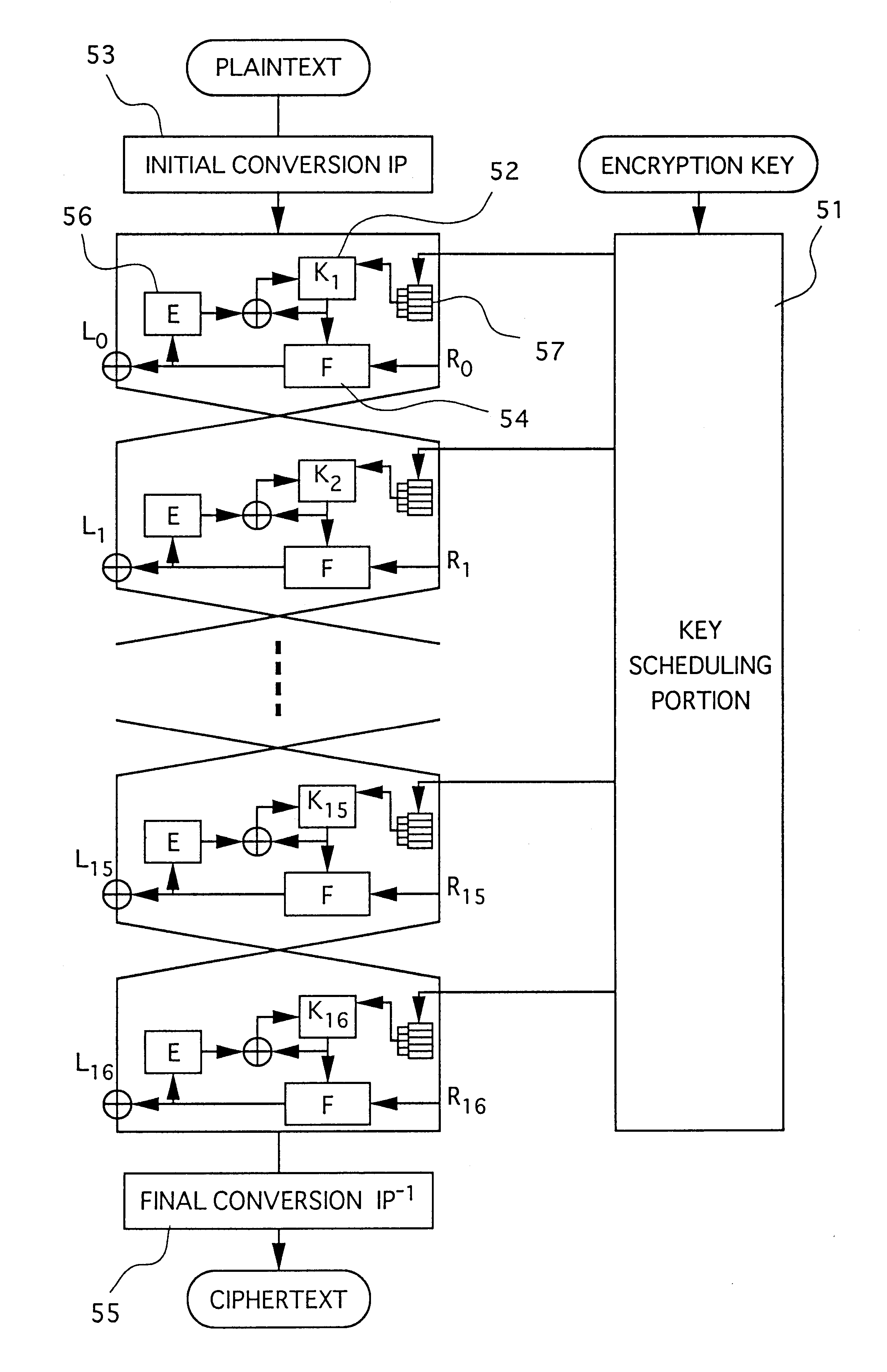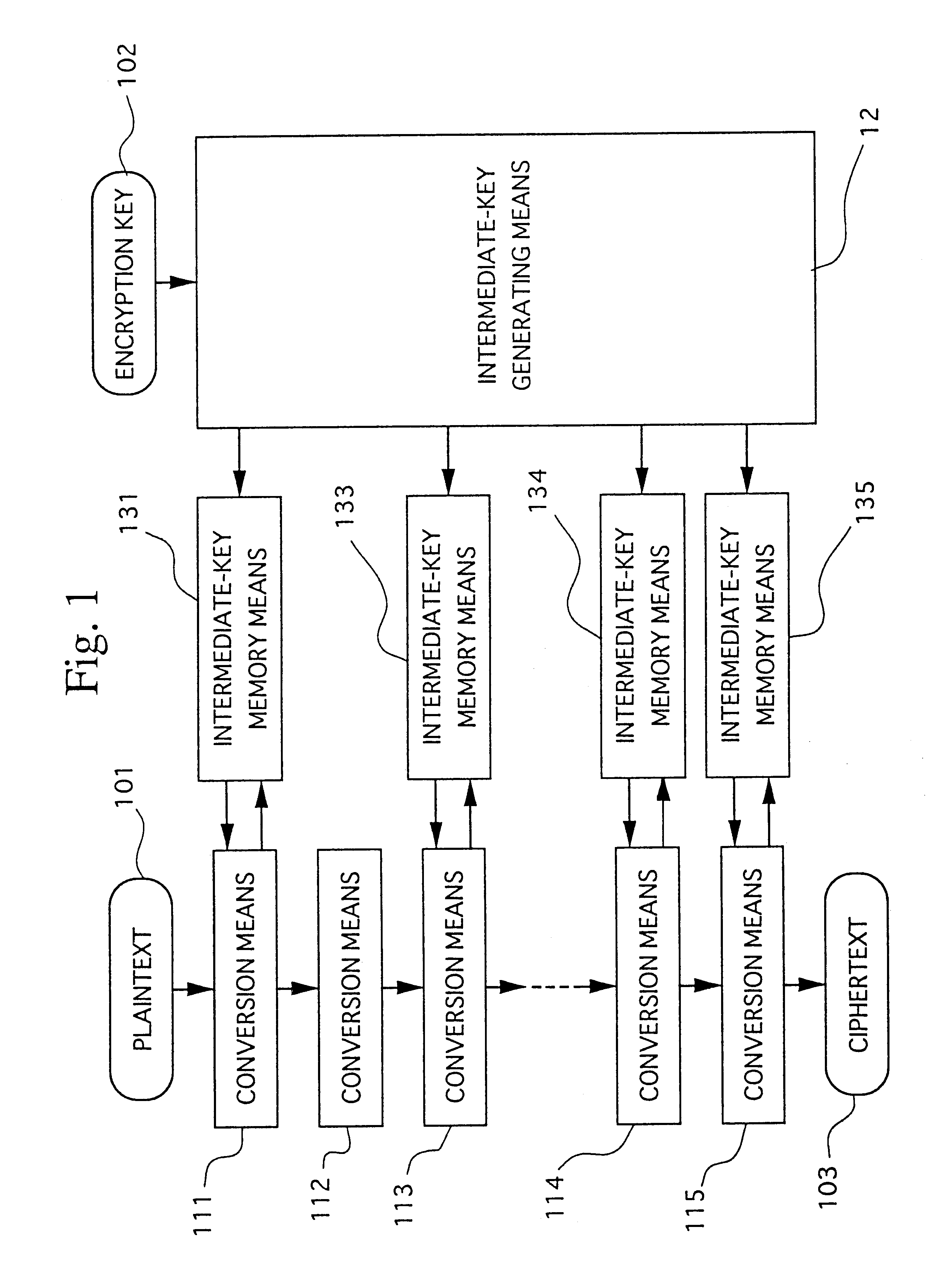Encryption apparatus and computor-readable recording medium containing program for realizing the same
a technology of a recording medium and a program, which is applied in the direction of multi-key/algorithm usage, digital transmission, instruments, etc., can solve the problems of identifying a change, unable to obtain a large tract of ciphertexts which use the same key, and lack of confidentiality
- Summary
- Abstract
- Description
- Claims
- Application Information
AI Technical Summary
Benefits of technology
Problems solved by technology
Method used
Image
Examples
first embodiment
FIG. 1 is a block diagram showing the present invention. FIGS. 2, 3, and 4 are diagrams for explaining a system disclosed in Japanese Patent Application, First Publication No. Hei 6-266284. The features of the present invention are described referring to those figures.
As shown in FIG. 1, a bit string called a plaintext is taken into the apparatus, a conversion operation is carried out by at least one conversion means 111 to 115 connected in series, and finally a cipher is output. Each conversion means 111 to 115 is not necessarily required to have an identical function. The conversion means 111 to 115 possess a function to perform a linear or non-linear conversion of the bit string, and this function is controlled by an intermediate-key which is stored in a memory means 131 to 135 associated with each conversion means. Furthermore, the conversion means 111 to 115 also possess a function to generate update-information whenever conversion of a bit string is performed and to transmit t...
seventh embodiment
the present invention will be described hereinafter referring to FIG. 13. This embodiment is a modified system of the fifth embodiment which updates the intermediate .key by adopting the intermediate-key update-information used by the intermediate-key update processor from the output data of the conversion means. The seventh embodiment of the present invention specifies the position for adopting the intermediate-key update-information complying with the fifth and sixth embodiments, and the system of this embodiment is suggested in the first embodiment indicated referring to FIG. 6.
FIG. 13 is a conceptual diagram showing the operation of this embodiment.
A conversion means D1 is the same as the F-function 61 shown in FIG. 6, and an intermediate-key update memory means D2 may be designed to be comprised of the expansion permutation 62, the intermediate-key update processor 64, and the intermediate-key initial-value memory 63, shown in FIG. 6. When this construction is formed, the struc...
second embodiment
In turn, the conversion means D1 is the same as the F-function 71 in FIG. 7, and the intermediate-key update memory means D2 comprises the expansion permutation 72, the intermediate-key update-information memory 73, the intermediate-key update processor 74, and the intermediate-key initial-value memory 75, shown in FIG. 7. When this construction is formed, the structure becomes identical with that of the second embodiment, which corresponds to the example which does not use the intermediate-key updated by the intermediate-key update-information adopted from the output of the conversion means for conversion of the data block adopted the intermediate-key update-information.
A higher confidentiality can be secured by using the seventh embodiment than the case of the fifth and sixth embodiment, because the intermediate-key is produced from data which are mixed by the conversion means, which makes it difficult to assume the intermediate-key update-information.
Next, the eighth embodiment o...
PUM
 Login to View More
Login to View More Abstract
Description
Claims
Application Information
 Login to View More
Login to View More - R&D
- Intellectual Property
- Life Sciences
- Materials
- Tech Scout
- Unparalleled Data Quality
- Higher Quality Content
- 60% Fewer Hallucinations
Browse by: Latest US Patents, China's latest patents, Technical Efficacy Thesaurus, Application Domain, Technology Topic, Popular Technical Reports.
© 2025 PatSnap. All rights reserved.Legal|Privacy policy|Modern Slavery Act Transparency Statement|Sitemap|About US| Contact US: help@patsnap.com



